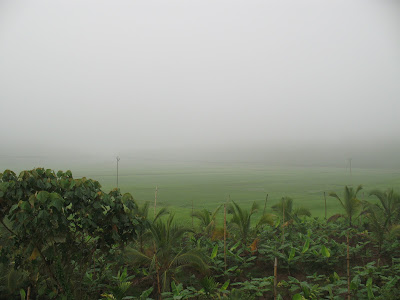A stubborn motorcyclist, it was hard for me to agree to the idea of buying a car. After persistent effort from the better half, we bought a pre-owned Hyundai i20 (CRDI – 2012 model) from a fellow TeamBhPian. The agreement was to ride 500 kilometres for every 1000 kilometres drive in the car. True to the promise, a three-day motorcycle trip was fulfilled the following month. The travelogue of both the trips is covered in this post. The travel diary of the car trip is from the first week of April, and the motorcycle is from the first week of May.
On a fine hot April morning, which also happened to be Ugadi – the spring festival of a new beginning - the drive to Wayanad began. Filled with hope that the upcoming year would be full of travel. Not aware of the road repair work completion on Kankapura road, a detour through Jigani brought us to Harohalli. The mild traffic helped in covering distance fast. Breakfast at Santrupti restaurant five kilometres after Harohalli was a brief stop. The route followed: Bangalore – Jigani – Kanakapura – Kollegala – Chamrajnagar - Gundlupet – Muthanga – Bathery – Muttil
The long and mild foggy mornings give way to humid and sultry afternoons followed by showers and cool nights. There is always a first time to everything. This was the first work-cation. The well-equipped Airbnb with fast internet, power backup and work-friendly furniture is a hint at work from anywhere becoming a reality and not just a dream anymore. To have an understanding boss who lets you work from anywhere is like a cherry on the cake.
The first stop at Airbnb is surrounded by greenery. The host was running a plant nursery until Covid struck and was in the process of restarting when we stayed there. Misty mornings enhanced the charisma of this mountain province. We indulged ourselves in the mysteriousness coupled with a cup of black tea (Kattan) – a perfect combination. The finest trio in Wayanad, in my opinion, is rain- KSRTC bus – black tea (Kattan)!
Taking advantage of the pleasant weather, we drove through winding roads of Panamaram-Kambalakadu-Padinjarethara and reached Banasura Dam. An interesting piece of engineering Banasura Sagar Dam is an earthen dam. It happens to be the largest in India and the second largest in Asia. It impounds a tributary of Kabini. The reservoir has led to the formation of umpteen islets. The mighty mountain ranges of Western Ghats form the backdrop offering a stunning panorama. The day was well spent with a drive through rain-drenched roads bordered by paddy fields extending over the horizon.
An obligatory visit to Thirunelly forest area to enjoy Unniappam and black tea at Kuttettan’s shop was the next plan. A deviation from Thirunelly temple road will take you to a small village -Appappara and this road connects to Tholpetty forest road leading from Kutta to Mananthavady.
The Kottiyoor Temple is located in a scenic valley bordering the Kottiyoor Reserve Forest. The winding roads stretched down almost to sea level. The weather in this part is hot and sultry, but the Bavali river gives a respite from the heat. The river meanders through the gentle vegetation across the temple ground. It is said that, at its zenith, the temple was second-wealthiest in terms of gold and precious stones in the Kerala region. The structure on the east bank opens during the Kottiyoor Vysakha Mahotsavam. The one on the west bank is open throughout the year. The hot afternoon put the air-conditioning of the car to test. Being thankful for the privilege of travelling by car, we climbed back to revel in the crisp mountain air.
The Wayanad Tea Museum at Pozhuthana is a good concept. An early visit meant the cafeteria at the museum was not open. All the excitement of tea tasting was fruitless. The winding roads to the museum are bordered by tea estates. Crisp early morning air added charm to the already fascinating landscape. They have a good collection of artefacts related to tea manufacturing and other mechanical machinery from the days of the British Raj. The two-storey façade was part of the archaic tea factory. Wooden structure creaks and squeals under your feet. The content is informative, but a little extra effort in proofreading will be highly appreciated.
Vellarikunnu is truly an off-beat place and ideal for a top view of the tea estate valleys. It is fascinating to see the tea plantation in a valley formation from above. A perfect place to watch sunset on a clear day. The summer showers meant no clear sky, and we satiated ourselves with amazing views of Chembra and other mountains around. A deviation from the main Kozhikode-Kalpetta highway takes you through narrow alleys, finally opening up to the tea plantations. A football ground on the way had a tree (a kind of pine) with unusual decor – football shoes hung on the branches. The road, after a while, is a dead end. It continues into the private tea estate road with restricted access.
While at Kalpetta town, spotting a private bus with the board Sugandhagiri intrigued our curiosity. Taking the Vythiri- Pookode Lake - Kolichal- road, a deviation after Kolichal and a long narrow road drive, we emerged at the road to Sugandhagiri. A small unpretentious hamlet - Sugandhagiri - is at the tip of a forest. It seemed to be mainly inhabited by the indigenous people. The road after this hamlet is through the jungle. Marking the route in favourites, to return with Jimny – if and when it launches in India – we turned back towards Chundale.







